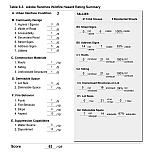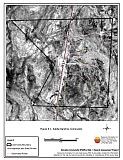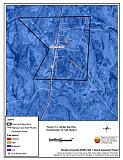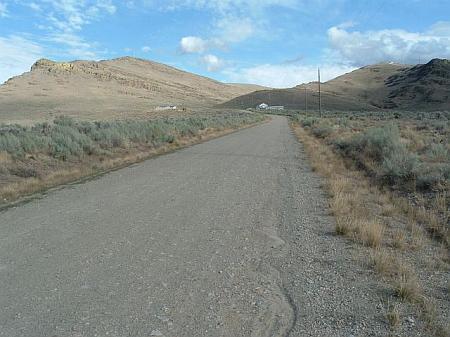9.0 Adobe Ranchos
9.1 Risk and Hazard Assessment
Adobe Ranchos is a small community located along Highway 225 approximately fifteen miles north of Elko in western Elko County. The town is situated along Adobe Creek at an elevation of approximately 6,000 feet. The community hazard assessment resulted in classifying Adobe Ranchos in the High Hazard category (63 points). A summary of the factors that contributed to the hazard rating is included in Table 9-3. The high rating is primarily attributed to limited access, inadequate defensible space, the potential for hazardous fire behavior, and the lack of fire protection resources and water availability. The community boundary identified for this report is shown in Figure 9-1.
9.1.1 Community Design
The wildland-urban interface area around Adobe Ranchos is an intermix condition. Structures are scattered throughout the community with no clear line of demarcation between structures and wildland fuels. All of the 21 homes assessed for this report are on parcels of one to ten acres in size.
- Access: State Route 225 is the major transportation route through Adobe Ranchos. The highway is at least 24 feet wide, paved, and has adequate space for fire suppression equipment to maneuver.
- Signage: All of the street signs are clearly posted, but only 33 percent of the homes have clearly visible address signage. Clear and visible signage is important to help emergency personnel in locating homes under low visibility conditions during a wildfire.
- Utilities: All of the utilities are above ground. Power line corridors need proper maintenance to minimize wildfire damage to electric utilities and reduce the possibility that sparks could start a fire in adjacent vegetation.
9.1.2 Construction Materials
All of the homes observed in the interface area are built with non-combustible or highly fire resistant siding materials such as medium density fiberboard and roofing materials such as composition roofing, metal, or tile. Twenty-four percent of the homes have unenclosed porches, decks, or balconies that create drafts and provide areas where sparks and embers can lodge, smolder, ignite, and rapidly spread fire to the house.
9.1.3 Defensible Space
Sixty-seven percent of the homes observed in the interface do not meet the minimum recommended defensible space requirement to help protect the home from damage or loss during a wildfire.
9.1.4 Suppression Capabilities
Wildfire Protection Resources
Adobe Ranchos has no organized fire department. Fire suppression resources are provided to Adobe Ranchos by the Elko Fire Department. Table 9-1 lists the types of wildfire resources and equipment available for initial response to the Adobe Ranchos in the event of a reported wildfire. Additional resources are available from local, state, and federal agencies through mutual aid agreements as described in Section 4.1.1.
| Type of Equipment | Amount of Equipment | Cooperating Partner (Resource Location) |
|---|---|---|
| Type 3 Engine Type 4 Engine Type 5 Engine Water tender |
1 1 1 1 |
Elko Fire Department Lee Company |
| Type 4 Engine | 1 | Bureau of Land Management (Elko) |
| Type 3 Helicopter Air Attack Platform |
1 1 |
Bureau of Land Management (Elko Helibase) |
| Type 2 Engine Type 1 Water Tender |
1 1 |
Nevada Division of Forestry (Elko) |
| Source: Sam Hicks, Nevada Division of Forestry Elko County Prevention Captain; Alan Kightlinger, Elko Fire Department Chief | ||
Water Sources and Infrastructure
Water available for fire suppression in Adobe Ranchos is limited to private wells and a reservoir about two miles away on Sixteen Mile Creek that could be used as a helicopter dip site.
9.1.5 Factors Affecting Fire Behavior
The terrain within the community boundary is gently rolling with slopes up to twenty percent and aspects in all directions. The prevailing wind direction is from the south and west. There is a history of afternoon thunderstorms and dry lightning strikes in the area. The vegetative fuel density in the Adobe Ranchos interface area is generally moderate, estimated at one to three tons per acre with a moderate fuel hazard. The fuel hazards in the interface area are shown in Figure 9-2. Fuels in the community consist primarily of cheatgrass, bluegrass, bottlebrush squirreltail, basin wildrye, big sagebrush, and low sagebrush. The grasses are typically six inches to three feet tall and the shrubs are one to three feet tall with moderate spacing. The fuel hazard photo point is shown in Figure 9-3.
9.1.6 Fire Behavior Worst Case Scenario
The worst-case scenario for a wildfire in the area surrounding Adobe Ranchos would be an ignition south of the community along State Route 225 with a strong south wind greater than twenty miles per hour pushing the fire north into residences. There is no local water storage for fire suppression and no local fire protection resources. Initial response fire suppression personnel are at least thirty minutes away.
9.1.7 Ignition Risk Assessment
Adobe Ranchos has a moderate to high risk of ignition based on fire history and dry lightning from thunderstorms in the area. The primary risk of ignition is lightning, although human caused ignitions are unpredictable and can happen at any time.
9.2 Risk and Hazard Reduction Recommendations
The responsibility to keep a community fire safe falls not only on the local fire protection district but also on the residents and local governments. The recommendations for the Adobe Ranchos area focus primarily on the ongoing and additional efforts to create and maintain defensible space and on future requirements that new developments will be planned and constructed to create fire safe communities. Other recommendations pertain to community coordination and public education efforts that could be undertaken to enhance fire safety.
9.2.1 Defensible Space Treatments
Defensible space treatments are an essential first line of defense for residential structures. The goal of the treatments is to significantly reduce or remove flammable vegetation within a prescribed distance from structures. (Refer to Appendix E for the minimum recommended defensible space area). Defensible space reduces the fire intensity and improves firefighter and homeowner chances for successfully defending a structure against oncoming wildfire.
Property Owners Recommendations
- Remove, reduce, and replace vegetation around homes according to the guidelines in Appendix E. This area should be kept:
- Lean: There are only small amounts of flammable vegetation.
- Clean: There is no accumulation of dead vegetation or other flammable debris.
- Green: Existing plants are healthy and green during the fire season.
- Store woodpiles a minimum distance of thirty feet from any structure.
- Remove all dead vegetation and other flammable materials a minimum of five feet from the exterior of the structure.
- Mow or remove brush growing against fences in the community. The minimum distance for clearance should be ten feet in grass and 25 feet in brush.
- Maintain areas under wood decks and porches free of weeds and other flammable debris. Enclose these areas when possible. Box in eves and cover attic and other ventilation openings with very fine metal wire mesh to prevent embers from entering the attic or crawl space.
- Clear all vegetation and combustible materials around propane tanks for a minimum distance of ten feet.
- Clear weeds and brush to a width of ten feet along both sides of the driveways.
- Where cheatgrass has become dominant within the defensible space zone, areas should be mowed prior to seed maturity or treated with an application of a pre-emergent herbicide. Treatments may need to be repeated for several years to ensure that the seed bank of unwanted annual grass seeds has been depleted. Refer to Appendix E for a recommended seed mixture and planting guidelines that can be used in conjunction with cheatgrass removal.
- Install spark arrestors on chimneys.
- Prune all tree branches to a minimum distance of fifteen feet from buildings, paying special attention around chimneys.
- Mow grass within the defensible space zone to maintain a maximum height of four inches.
- Immediately dispose of cleared vegetation when implementing defensible space treatments. This material dries quickly and poses a fire hazard if left on site.
- Where possible, irrigate all trees and large shrubs that remain in close proximity to structures to increase their fire resiliency. This is especially important during drought conditions.
- Maintain the defensible space as needed.
9.2.2 Fuel Reduction Treatments
Fuel reduction treatments are applied on a larger scale than defensible space treatments. Permanently changing the fuel characteristics over large blocks of land to one of a lower volume and one of altered distribution reduces the risk of a catastrophic wildfire in the treated area. Reducing vegetation along roadways and driveways could reduce the likelihood of blocking access and escape routes, help contain the fire perimeter, and improve firefighter access and safety for protecting homes.
Utility Company
- Reduce and remove vegetation to maintain clearance around power lines. Clear vegetation within fifteen feet of utility poles near the community.
Elko County Roads Department and Nevada Department of Transportation
- Reduce vegetation and maintain roads by mowing all vegetation to a height of no more than four inches for a distance of twenty feet from the edge of the road on both sides of the road. Remove and dispose of biomass at an appropriate site. Reseed treated areas with fire resistant species such as recommended in Appendix E to minimize cheatgrass and noxious weed invasion.
9.2.3 Fire Suppression Resources
Nevada Division of Forestry
- Enforce the existing brush clearance program to include cleaning weeds and debris from around structures and fences in the community.
- Install a minimum capacity 10,000-gallon water tank in the community for fire suppression.
- Continue to meet annually with the cooperating agencies to discuss pre-attack plans for the community.
9.2.4 Community Coordination
Property Owners
- Ensure residential addresses are easily visible from the road. Address characters should be at least four inches tall and reflective on a dark background. Improving the visibility of addresses will facilitate the navigation of unfamiliar neighborhoods for rescue and suppression personnel during a wildfire event.
- Form a local community-based organization to take responsibility and provide leadership for community-wide fuels reduction and community fire safety. The Nevada Fire Safe Council is one option for community organization. Through the establishment of a local Nevada Fire Safe Council Chapter, local communities will become part of a large network for sharing information, including notification of programs and funding opportunities for fire mitigation projects such as those listed in this report. The Nevada Fire Safe Council will accept and manage grants and contracts on the Chapter’s behalf through its non-profit status. The Nevada Fire Safe Council will provide assistance and support to communities to complete fire safe plans, set priorities, educate and train community members, and promote success stories of its members. To form a local chapter or for more information contact the:
Nevada Fire Safe Council
210 South Roop Street Suite 101
Carson City, NV 89701
www.nvfsc.org
Elko County
- Promote cooperation between the Assessor’s Office and the Roads Department to ensure that all new development roads are named, mapped, signed, and identified with GPS locations.
- Continue to require all future development in the County to meet the National Fire Codes with regard to community design, building construction and spacing, road construction and design, water supply and emergency access. Refer to Appendix F for an example of fire safe recommendations for planning new developments.
9.3 Summary of Recommendations
| Involved Party | Recommended Treatment | Recommendation Description |
|---|---|---|
| Property Owners |
Defensible Space | Remove, reduce, and replace vegetation around homes according to the guidelines in Appendix E. Maintain the defensible space area annually. |
| Community Coordination | Ensure residential addresses are easily visible from the road. Form a local community-based organization to provide leadership and be responsible for community-wide fuels reduction and community fire safety. |
|
| Utility Company | Fuels Reduction | Reduce and remove vegetation to maintain clearance around power lines. Clear vegetation within fifteen feet of utility poles near the community. |
| Elko County Nevada Department of Transportation |
Fuels Reduction | Reduce vegetation and maintain roads by mowing all vegetation to a height of no more than four inches for a distance of twenty feet from the edge of the road on both sides of the road. Remove and dispose of biomass at an appropriate site. |
| Elko County | Community Coordination | Promote cooperation between the Assessor’s Office and the Roads Department to ensure that all new development roads are named, mapped, signed, and identified with GPS locations. Continue to require all future development in the County to meet the National Fire Codes with regard to community design, building construction and spacing, road construction and design, water supply and emergency access. Refer to Appendix F for an example of fire safe recommendations for planning new developments. |
| Nevada Division of Forestry | Fire Suppression Resources | Install a minimum capacity 10,000-gallon water tank in the community for fire suppression. Continue to meet annually with the cooperating agencies to discuss pre-attack plans for the community. |
Table 9-3Adobe Ranchos Wildfire Hazard Rating Summary |
 |
Figure 9-1Adobe Ranchos Community |
 |
Figure 9-2Adobe Ranchos Classification of Fuel Hazard |
 |
Figure 9-3. Adobe Ranchos Fuel Hazard Photo Points
Photo Point 1. 4532116N, 0596097E, 135°SE. The dominant vegetation in the Adobe Ranchos community includes cheatgrass, bluegrass, bottlebrush squirreltail, basin wildrye, big sagebrush, and low sagebrush. The fuel load was estimated between one and three tons per acre and considered a moderate fuel hazard.

